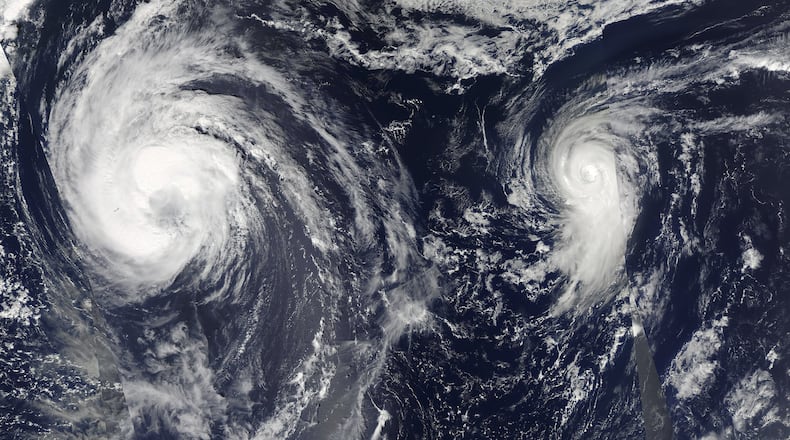The Atlantic hurricane season will be “near-normal” with two to four major hurricanes expected in 2019, according to national forecasters. But the southeastern U.S. still grappling with impacts from the only two major hurricanes to make landfall during 2018 shows even a near-normal season can prove devastating.
RELATED: Hurricane season and summer are back. Some Florida beach towns aren’t.
“Even though those ranges are centered on what an average season would bring, that is a lot of activity,” said Gerry Bell, lead seasonal hurricane forecaster for the National Oceanic and Atmospheric Administration. “It doesn’t mean the season is going to be quiet. You need to start getting prepared now as with every hurricane season.”
The best preparations may not help victims find relief, however. As the new hurricane season picks up, victims from recent natural disasters are still waiting for Congress to approve a $19.1 billion relief bill. On Friday, final passage of the plan was blocked by Rep. Chip Roy (R-Texas), who forced a delay until Congress returns for legislative business in the first week of June when the new hurricane season officially begins.
Hurricane season runs from June 1 through Nov. 30, and an average season produces 12 named storms with six becoming hurricanes and three turning into major hurricanes. For 2019, NOAA predicts nine to 15 named storms (winds of 39 mph or higher are given a name), of which four to eight could become hurricanes (74 mph winds or higher) and two to four could be major, classified as Category 3, 4 or 5 with winds of 111 mph or higher. In 2018, there were 15 named storms, including eight hurricanes, of which two — Florence and Michael — were classified as major.
Channel 2 Action News meteorologist Glenn Burns cautions that no matter the level of the storm, it is important for people to take proper precautions. “You can have a Category 4 hurricane that moves quickly across the area, but even if you have a Category 2 that moves slower, that would be more impactful because of the duration,” he said.
Hurricanes are fueled by warm, moist air continually rising up from the ocean’s surface. As the air rises and cools, the water in the air forms clouds. The clouds continue to form, creating huge bands that spin, blow and grow larger as they are fed by the ocean’s heat and evaporating water.
Since 1995, we have been in the active phase of the Atlantic Hurricane Cycle, said Judith Curry, professor emeritus and former chair of Atmospheric Science at Georgia Tech and president of the Climate Forecast Applications Network. Recent elevated hurricane activity in the Atlantic is comparable to a period in the 1930s to 1950s during which some of the worst landfalls occurred, she said.
Current El Nino conditions, the periodic warming of the sea surface temperatures across the equatorial Pacific Ocean, may suppress the intensity of hurricane season by increasing wind shear over the Caribbean Sea, blowing apart storms or preventing them from developing altogether, said Bell.
But this year, El Nino, last seen in 2015, is relatively weak, said climate experts, and its effect could be countered by warmer-than-average sea surface temperatures in the Atlantic Ocean and Caribbean Sea along with a wind system that affects West African regions, both of which set the scene for increased hurricane activity.
As the storms begin to form, forecasters will refine their predictions to focus on intensity and landfall, but that presents the greatest challenge.
“We can go out five days and be spot on as to where the storm is going to hit,” said Burns. “Intensity is the biggest problem in hurricane forecasting.”
Hurricanes tend to lose strength over land, but they can be very unpredictable. “The key challenge is predicting rapid intensification, especially when it occurs just before landfall, such as happened last year with Hurricane Michael,” said Curry. “Rapid intensification is driven in part by small-scale, random processes that are difficult for the models to predict.”
Hurricane Michael, classified as a Category 3 storm when it moved into southwest Georgia on Oct. 10, was the first major hurricane to hit the state since the late 1800s.
READ MORE: A look at some of Georgia's worst hurricanes
The main impact from hurricanes inland is flooding rain and tornadoes, Burns said. “Tornadoes can spin up, boom and they are gone. They are small…and they are difficult to find in the outer bands. We have to be very diligent,” he said.
In preparation for storm season, state agencies led by GEMA will soon participate in a statewide hurricane exercise designed to test disaster plans and procedures, officials said.
When hurricanes lead to a state of emergency in Georgia the Emergency Operations Plan is activated. The plan was updated in 2017, an above average season which brought six major hurricanes.
2019 Atlantic Tropical Cyclone Names
Andrea
Barry
Chantal
Dorian
Erin
Fernand
Gabrielle
Humberto
Imelda
Jerry
Karen
Lorenzo
Melissa
Nestor
Olga
Pablo
Rebekah
Sebastien
Tanya
Van
Wendy
Source: NOAA
About the Author
The Latest
Featured


